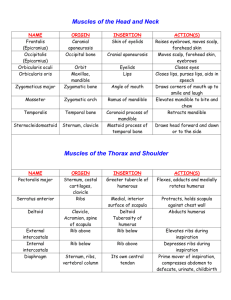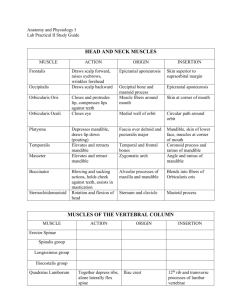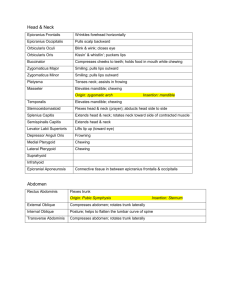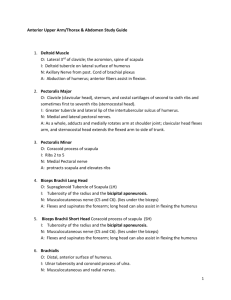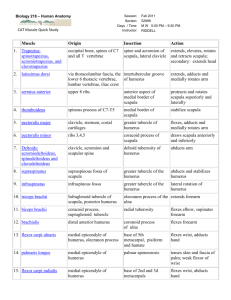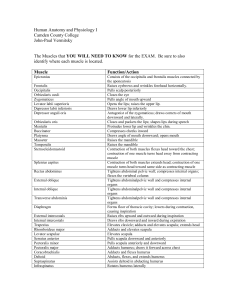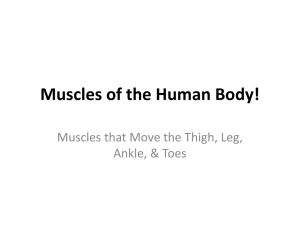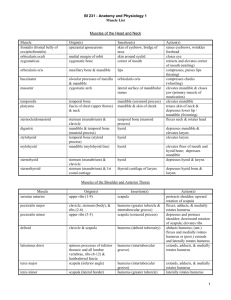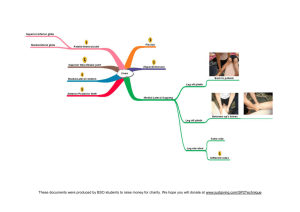Name of Muscle Actions Origin Insertion Head, Face & Neck
advertisement
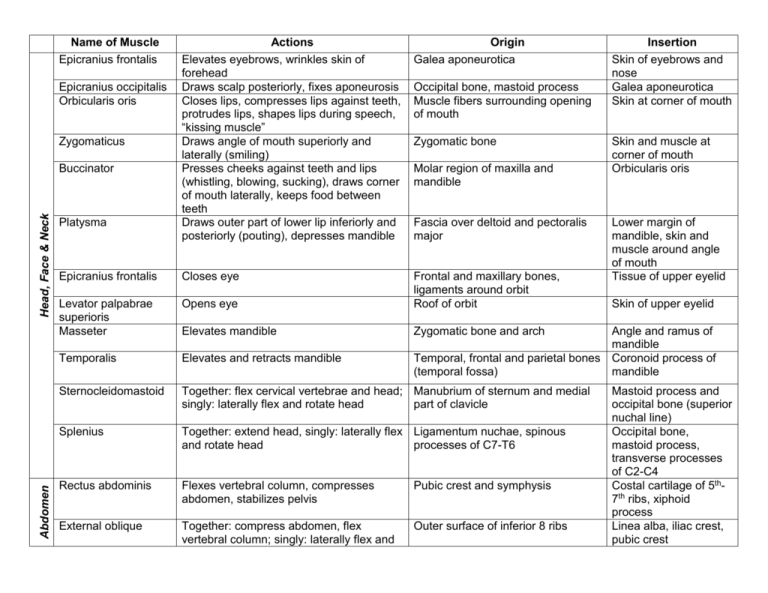
Name of Muscle Epicranius frontalis Galea aponeurotica Epicranius frontalis Closes eye Levator palpabrae superioris Masseter Opens eye Frontal and maxillary bones, ligaments around orbit Roof of orbit Elevates mandible Zygomatic bone and arch Temporalis Elevates and retracts mandible Sternocleidomastoid Together: flex cervical vertebrae and head; Manubrium of sternum and medial singly: laterally flex and rotate head part of clavicle Splenius Together: extend head, singly: laterally flex Ligamentum nuchae, spinous and rotate head processes of C7-T6 Rectus abdominis Flexes vertebral column, compresses abdomen, stabilizes pelvis Pubic crest and symphysis External oblique Together: compress abdomen, flex vertebral column; singly: laterally flex and Outer surface of inferior 8 ribs Zygomaticus Buccinator Head, Face & Neck Origin Elevates eyebrows, wrinkles skin of forehead Draws scalp posteriorly, fixes aponeurosis Closes lips, compresses lips against teeth, protrudes lips, shapes lips during speech, “kissing muscle” Draws angle of mouth superiorly and laterally (smiling) Presses cheeks against teeth and lips (whistling, blowing, sucking), draws corner of mouth laterally, keeps food between teeth Draws outer part of lower lip inferiorly and posteriorly (pouting), depresses mandible Epicranius occipitalis Orbicularis oris Abdomen Actions Platysma Occipital bone, mastoid process Muscle fibers surrounding opening of mouth Zygomatic bone Molar region of maxilla and mandible Fascia over deltoid and pectoralis major Insertion Skin of eyebrows and nose Galea aponeurotica Skin at corner of mouth Skin and muscle at corner of mouth Orbicularis oris Lower margin of mandible, skin and muscle around angle of mouth Tissue of upper eyelid Skin of upper eyelid Angle and ramus of mandible Temporal, frontal and parietal bones Coronoid process of (temporal fossa) mandible Mastoid process and occipital bone (superior nuchal line) Occipital bone, mastoid process, transverse processes of C2-C4 Costal cartilage of 5th7th ribs, xiphoid process Linea alba, iliac crest, pubic crest Internal oblique Thorax & Back Thorax & Back Breathing Transversus abdominis Diaphragm rotate vertebral column Together: compress abdomen, flex vertebral column; singly: laterally flex and rotate vertebral column Compress abdomen Iliac crest, inguinal ligament, lumbar fascia Linea alba, pubic crest, cartilage of last few ribs Linea alba, pubic crest Inspiration Iliac crest, inguinal ligament, lumbar fascia, cartilages of inferior 6 ribs Inferior internal surface of ribcage and sternum, costal cartilages of inferior 6 ribs, lumbar vertebrae External intercostals Elevate ribs during inspiration Inferior border of rib above Superior border of rib below Internal intercostals Draw ribs together during forced expiration Superior border of rib below Inferior border of rib above Pectoralis major Flexes arm (PM), adducts arm, medially rotates arm Clavicle, sternum cartilages of first 6 Greater tubercle of or 7 ribs, aponeurosis of external humerus oblique Pectoralis minor Draws scapula forward and downward when ribs fixed, elevates 3rd-5th ribs during forced expiration when scapula is fixed 3rd-5th ribs Coracoid process of scapula Serratus anterior Holds scapula against chest wall, rotates scapula, important to stabilize shoulder for arm movements (pushing, punching) Superior 8 or 9 ribs Anterior surface of vertebral border of scapula Deltoid Abducts arm (PM), anterior fibers flex and Clavicle, acromion and spine of medially rotate arm, posterior fibers extend scapula and laterally rotate arm Trapezius Stabilize scapula, superior fibers elevate scapula and extend head, middle fibers adduct scapula, inferior fibers depress scapula Central tendon Deltoid tuberosity of humerus Superior nuchal line of occipital Clavicle, acromion and bone, ligamentum nuchae, spines of spine of scapula C7 and all thoracic vertebrae Latissimus dorsi Extends arm (PM), adducts arm, medially rotates arm, draws arm inferiorly and posteriorly Spines of inferior 6 thoracic vertebrae and lumbar vertebrae (via thoracolumbar fascia), iliac crest, inferior 3-4 ribs, inferior angle of scapula Infraspinous fossa of scapula Intertubercular groove of humerus Infraspinatus Laterally rotates arm, stabilizes shoulder Teres minor Laterally rotates arm, stabilizes shoulder Lateral border of posterior surface of scapula Greater tubercle Teres major Extends arm, adducts arm, medially rotates arm Flexes forearm, supinates forearm, flexes arm Inferior angle of scapula on posterior surface Tubercle above glenoid cavity (long head), coracoid process (short head) Lesser tubercle on anterior humerus Radial tuberosity Brachialis Flexes forearm Distal anterior surface of humerus Coronoid process of ulna, capsule of elbow joint Triceps brachii Extends forearm (PM) Projection inferior to glenoid cavity (long head), posterior surface of humerus (lateral and medial heads) Olecranon process Brachioradialis Flexes forearm, stabilizes elbow Lateral border of distal end of humerus Base of styloid process of radius Pronator teres Pronates forearm, weakly flexes forearm Medial epicondyle, coronoid process Midlateral surface of radius Flexor carpi radialis Flexes hand, abducts hand Medial epicondyle Base of 2nd and 3rd metacarpals Palmaris longus Weakly flexes hand Medial epicondyle Deep fascia of palm Flexor carpi ulnaris Flexes hand, adducts hand, stabilizes wrist Medial epicondyle, olecranon process and posterior surface of ulna Upper Limb Upper Limb Biceps brachii Greater tubercle Some carpals, base of 5th metacarpal Buttock & Lower Limb Flexor digitorum superficialis Flexes middle phalanx of each finger at proximal interphalangeal joint, flexes proximal phalanx of each finger at metacarpophalangeal joint, flexes hand Medial epicondyle, coronoid process, anterior surface of radius Middle phalanges of each finger Extensor carpi radialis Extends hand, abducts hand Lateral supracondylar ridge of humerus Base of second metacarpal Extensor digitorum Extends fingers (PM), extends hand Lateral epicondyle Distal and middle phalanges of each finger Extensor carpi ulnaris Extends hand, adducts hand Lateral epicondyle, posterior border of ulna Base of 5th metacarpal Abductor pollicis brevis Abducts thumb at carpometacarpal joint Deep fascia of palm, some carpals Lateral side of proximal phalanx of thumb Flexor pollicis brevis Flexes thumb at carpometacarpal and metacarpophalangeal joint Deep fascia of palm, some carpals Lateral side of proximal phalanx of thumb Gluteus maximus Extends thigh, laterally rotates thigh, abducts thigh Ilium, sacrum, coccyx, aponeurosis of sacrospinalis Iliotibial tract, gluteal tuberosity of femur Gluteus medius Abducts thigh, medially rotates thigh, stabilizes pelvis Lateral surface of ilium Greater trochanter Rectus femoris Extends leg, flexes thigh Anterior inferior iliac spine Patella via quadriceps tendon to tibial tuberosity via patellar ligament Buttock & Lower Limb Vastus lateralis Extends leg Greater trochanter, intertrochanteric line, linea aspera Patella via quadriceps tendon to tibial tuberosity via patellar ligament Patella via quadriceps tendon to tibial tuberosity via patellar ligament Medial surface of tibia Vastus medialis Extends leg Intertrochanteric line, linea aspera Gracilis Adducts thigh, flexes leg Pubic bone, ischial ramus Adductors Adducts thigh, flexes thigh, medially rotates thigh Pubic bone, ischial tuberosity and ramus Linea aspera of femur and inferior portions of femur Pectineus Flexes thigh, adducts thigh Superior ramus of pubis Femur between lesser trochanter and linea aspera Iliopsoas Flexes thigh/trunk (PM), psoas portion also Iliac fossa, T12 and lumbar does lateral flexion of vertebral column vertebrae Lesser trochanter Sartorius Flexes leg, flexes thigh, abducts thigh, laterally rotates thigh Anterior superior iliac spine Medial surface of tibia Tensor fasciae latae Flexes thigh, abducts thigh, medially rotates thigh Iliac crest Iliotibial tract Biceps femoris Flexes leg, extends thigh Ischial tuberosity (long head), linea aspera of femur (short head) Head of fibula, lateral condyle of tibia Semitendinosus Flexes leg, extends thigh Ischial tuberosity Proximal part of medial surface of tibia Semimembranosus Flexes leg, extends thigh Ischial tuberosity Medial condyle of tibia Tibialis anterior Dorsiflexes foot (PM), inverts foot Lateral condyle of tibia and interosseous membrane First metatarsal, one tarsal Extensor digitorum longus Dorsiflexes foot, Extends toes (PM) at metatarsophalangeal joint Lateral condyle of tibia, anterior surface of fibula, interosseous membrane Middle and distal phalanges of toes 2-5 Fibularis (Peroneus) longus Plantar flexes foot, everts foot Head and lateral side of fibula, lateral condyle of tibia Passes under foot to first metatarsal and one tarsal Gastrocnemius Plantarflexes foot, flexes leg Lateral and medial condyles of femur Calcaneus Soleus Plantarflexes foot Superior tibia, fibula and interosseous membrane Calcaneus Special Note: Keep in mind that to describe an action, you must name the movement, and name either the part of the body that is moving or the joint at which the movement occurs. For example, you may say that a particular muscle “flexes leg” or “flexes knee” – both of those mean the same thing. You may NOT say “moves knee” – that is not specific enough. So which terms to describe body parts are essentially interchangeable? Head or neck (cervical vertebrae) Arm or shoulder Forearm or elbow Hand or wrist Thigh or hip Leg or knee
